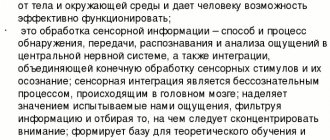Sensory integration: how to teach a child to feel correctly?
How is a child’s ability to perceive and process information formed? Why do violations occur in this process and what to do about it? These aspects were highlighted by Lyubov Filatova, a speech pathologist working with preschool children, during the “City of Health” fair.
A journalist from the Sibmeda portal attended Lyubov Gennadievna’s lecture “Sensory Integration. What is this?".
Reasons for violations
According to the specialist, the ability to combine information received through several channels of perception and further interpret it plays a central role in a child’s development. In medical terminology, this ability is called sensory integration. It is with the incorrect development of this ability, Lyubov Gennadievna assures, that many developmental deviations that are common today in preschoolers and children of primary school age are associated.
In particular, we are talking about such common diagnoses in recent years as “hyperactivity and attention deficit disorder” and autism spectrum disorders. So why do children have impaired ability to adequately perceive the world around them?
Main causes of sensory integration disorders
lie in congenital problems, as well as in disruption of the process of compensatory development of a young child.
The fact is that even before birth, three key sensory systems are formed - vestibular, tactile and proprioceptive (balance, skin sensitivity, body perception), later olfactory, visual, auditory and gustatory are formed. It depends on them how sensorimotor and perceptual development will proceed, how the child’s cognitive abilities will be formed, and, ultimately, learning.
It must be taken into account that from birth, children develop harmoniously only under the condition of constant stimulation by sensations from their own body and the environment.
Therefore, there are prerequisites for disruption of sensory (sensory) perception, which are formed under the influence of external factors. These include an excess or, conversely, a lack of so-called sensory information - sounds, touches, smells and colors surrounding the baby.
According to the specialist, today children are increasingly receiving less impressions from emotional and tactile communication.
– modern young families, as a rule, live quite separately.
Therefore, the optimal conditions for most young children, according to Lyubov Filatova, may be the frequent presence of relatives, and ideally, the environment of a large family.
But for children with any disabilities, the process of sensory integration becomes ineffective (they may be too or not sensitive enough to sensory stimuli).
“If a lot of sensory information comes in, the brain is overloaded, and a child with increased sensitivity becomes more intolerant of bright colors, household noises, visual and tactile stimuli.
– explains Lyubov Filatova.
In order to avoid uncomfortable sensations, the child tries to protect himself from external interference, forming negative selectivity to sensory stimuli. He avoids contact, hides, refuses to be touched. The second side is when the child does not receive enough sensory information. In this case, there is a decrease in sensitivity to sensory stimuli, which can manifest itself, for example, in monotonous manipulations with objects.
«In the distorted development of perception, one can see the presence of changes in the holistic picture of the real objective world, the isolation of individual sensations of one’s own body, sounds, forms of surrounding things
,” Lyubov Gennadievna continues to talk about the consequences of improper development of perception.
“ These are, of course, children with autism spectrum disorders who “snatch” a piece from real life: either they just roll an airplane, or spin, or see only the crocodile’s eyes and teeth, but cannot see it in its entirety
.”
At the same time, the specialist emphasizes: it would be wrong to blame parents for such deviations. It is only important to take into account factors that may in one way or another affect the development of the child.
Speech is the result of the development of feelings
As a teacher-defectologist, the defectologist’s frequent visitors are parents with children who do not begin to speak for a long time. However, the specialist emphasizes: such cases are a reflection of problems with the perception system. After all, it is the primary sensations and feelings that form memory, thinking and imagination, and on their basis speech appears.
Lyubov Filatova describes the process of formation of the speech function: before birth, sensations are formed that give us knowledge about our own body (vestibular, tactile and proprioceptive systems). On their basis, the abilities to hear, see, smell and taste appear, then the ability to plan movements, concentrate attention and control one’s actions. And based on all of the above, a person acquires the ability to produce speech.
“Now there are many children who seem to have mastered letters and learned to form syllables, but cannot read a whole word,” says Lyubov Gennadievna. “It’s useless to sit and endlessly “peck” with such a child, you need to correct it in another place, much earlier, and only then return to reading.”
How to correct violations: simple tips
The goal of therapy for sensory disturbances is to enhance or balance the central nervous system's ability to process external stimuli. Often, special tools are used for this, which are available in abundance on sale today - all kinds of rugs, bags of sand, and so on. But most often, sensitivity deviations can be corrected using the simplest means at hand. Lyubov Filatova described all kinds of sensory disorders along with ways to correct them, we will give some of them as examples.
Thus, with reduced sensitivity of the vestibular function
the child feels the need to swing, turn and spin. In this case, swings and carousels will come to the rescue, as well as playing ball, walking on stairs and all kinds of curbs.
With increased sensitivity of the vestibular function
The child has difficulty playing sports and often gets motion sickness in transport. To correct this deviation, it is worth dividing large activities into smaller, easier ones, and using visual cues, for example, the finish line.
For kids from both categories
, as well as those who do not have deviations, will benefit from various ladders and special structures on playgrounds.
But increased concern for children climbing these structures is unlikely to benefit them. According to the defectologist, parents should not pull their children away from sports and play equipment, because only with their help do children develop coordination, the vestibular apparatus, as well as muscle and tactile sensitivity.
Children whose sense of touch is underdeveloped
, usually have a fairly high pain threshold, often they even cause damage to themselves. The problem with these kids is that they don’t seem to feel their own body. They can be helped by massage, contact with special balls and prickly surfaces.
With increased tactile sensitivity
any touch will cause discomfort or even pain to the child. In this case, it is necessary to warn the child if you are going to touch him, allow him to comb his hair, wash himself and dress himself. In addition, such a child will benefit from playing with paints, soap bubbles, sand and water, as well as touching fabrics of various textures. Special rugs that can be found on sale today will also teach you not to be afraid of touching.
Children often experience disturbances in the perception of taste.
. This usually manifests itself in self-will when choosing food, which hides sensitivity to its texture, smell and taste. In this case, in addition to consulting with a doctor who will help you choose a diet for your child, you can change the structure of the food - for example, make mashed potatoes instead of sliced potatoes, and also let your child try different foods.
It is not so difficult to correct sensory disturbances in a child, so there is no need to despair when you discover childhood problems that are so common today. The main thing is to pay attention to alarming symptoms in time and consult a pediatrician as quickly as possible.
Correction of proprioception impairment
Sensory therapists in Europe are trained for 2 years. There are practically no such specialists in our country, but knowledge is gradually penetrating to us. What can be used to help such children (but in no case should you use violence, act through screaming and tears, the most important principle is “do no harm”):
- Weighted vest (good for hyperactive children; you can’t wear it all day! You need to wear it 3-4 times a day for 20 minutes);
- Weighted blanket (if you are going to put your child to sleep under it all night, the blanket should weigh no more than 15-20% of the child’s weight; it is better to use a weighted blanket for falling asleep, calming, relaxing, sensory unloading, and then put it away). It can also be used by normal children and adults to relieve stress;
- Wilbarger Protocol – a procedure for relieving tension through massage with a special stiff brush;
- Games for clapping, squeezing, tickling;
- Massage;
- Climbing through organized tunnels (for example, from blankets or special equipment for sensory integration), tight spaces;
- Sensory stocking (a special elastic stocking that is worn over the entire body, and when moving in the game, resistance to the fabric is formed);
- Motor correction, exercise therapy, physical activity, sensorimotor correction (some exercises cannot be used for children with epiactivity);
- Vibration (not for people with epiactivity).
Neuropsychologist Alexandrova O.A.
To make an appointment with a neuropsychologist, call (812) 642-47-02 or fill out the form on the website.
Sensory modulation disorders: HYPO- and HYPER-sensitivity
These sensory disorders are most often observed. Their severity may vary from patient to patient. In some children, the lack or excess of response to a stimulus is barely noticeable. For others, it is so pronounced that it is difficult for them to live and study normally.
Only one sphere of feelings may be damaged, several or absolutely all.
The child may be irritated by the feeling of fabric rubbing against the skin, may not tolerate normal room lighting, may not like touch (especially light touch), and may avoid direct eye contact.
With hyposensitivity, on the contrary, the child may actively seek some kind of sensory experience and be restless in its absence.









